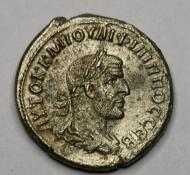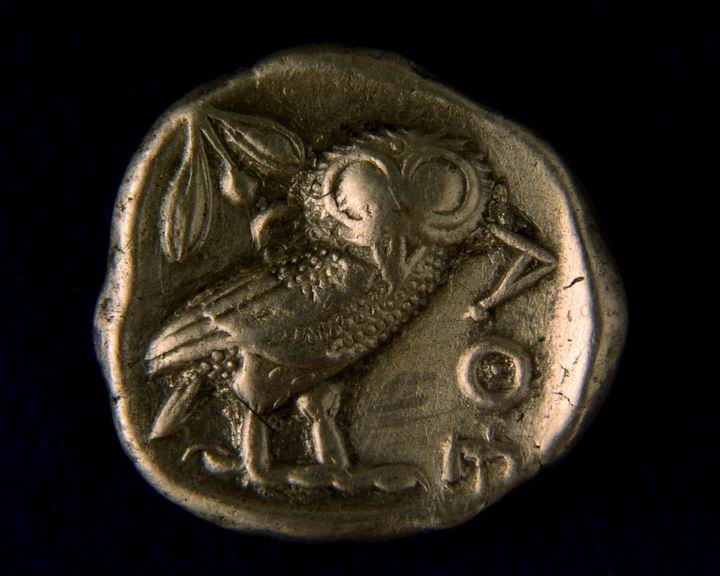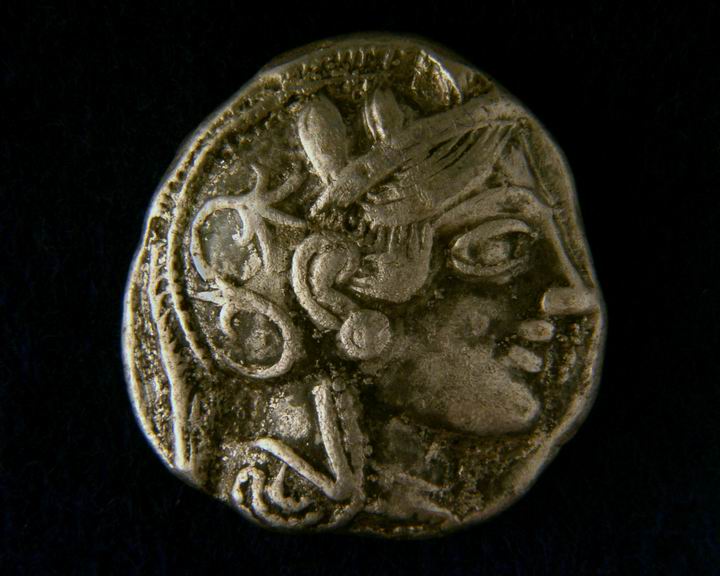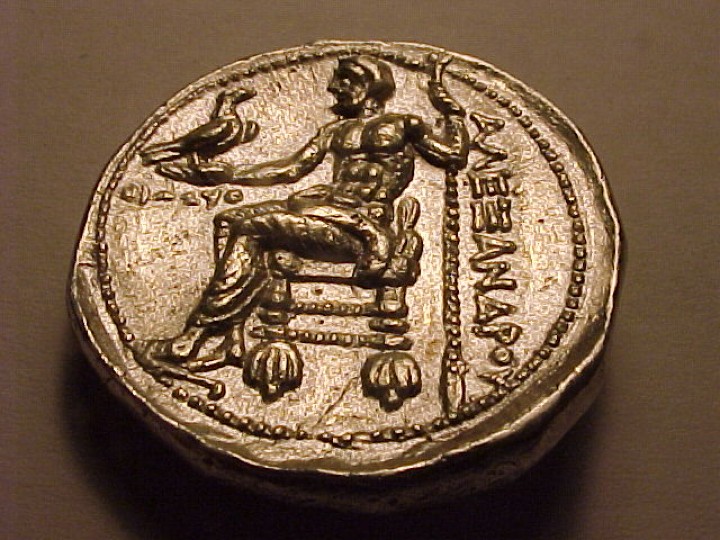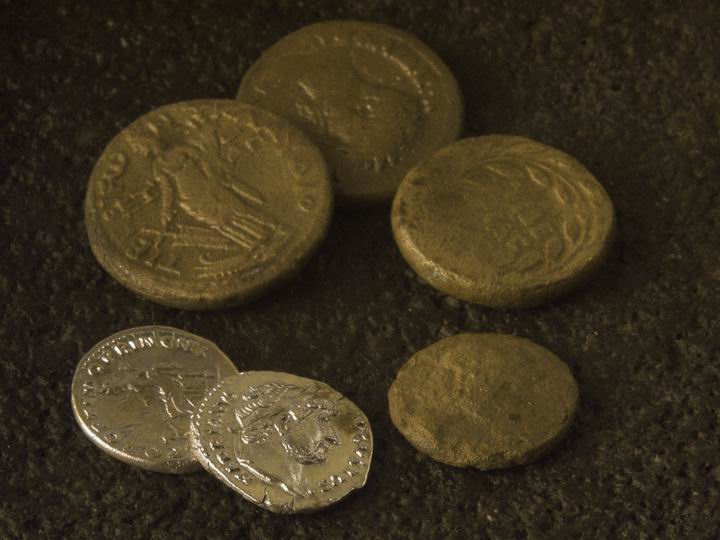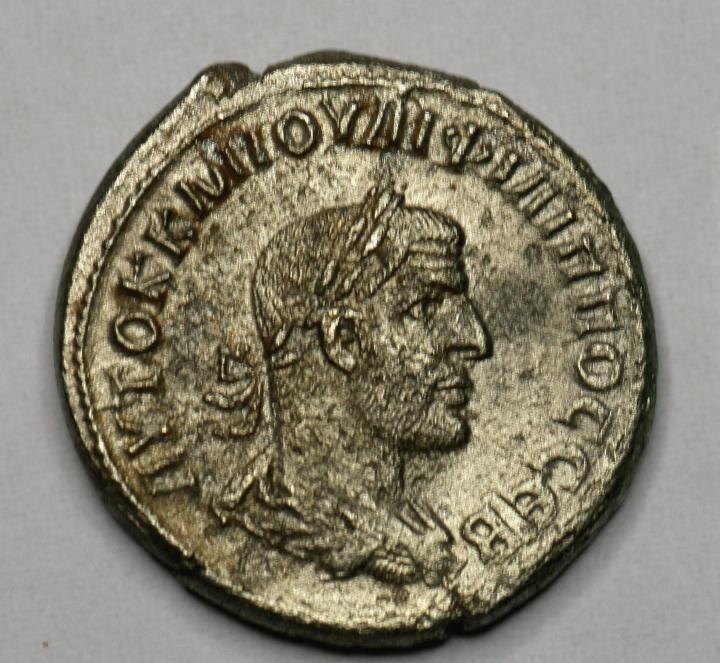This web page presents some of the coins found in the Bethsaida et-Tell excavations.
Home > Sites > Golan > Coins from Bethsaida et-Tell excavations
Contents:
Background
Photos
* Greek
* Roman
* Conclusions
References
Links
Background:
Many ancient coins were found in the excavations of Bethsaida in et-Tell. This web page presents a sample of these coins.
For a detailed review of Bethsaida et-Tell site – refer to its main web page.
Photos :
All photos courtesy of Dr. R. Arav.
(a) Greek coins:
- Owl and Athena
One of the most common symbols on Greek coins is the little owl of Athens. The Greek letters “ΑΘΕ” represent the first letters of the word Athens, which was the leading Greek city state. The Athenian coin was the “king” of international commerce during the 5th and 4th C BC, and was very common in the Israeli numismatics and found in many excavations in cities with a Persian period layer.
Note that the prototype Athenian coin was imitated and minted locally in several Israeli cities during the Hellenistic period.
Click on the photos to view in higher resolution…
The observe side of the owl coin shows the face of Athena. One of the most prominent of all the Greek deities, she was the city goddess of Athens and of Corinth, and goddess of war and peace.
- Alexander the Great
The next coin shows a typical Greek coin, which is an imitation of the series known as “Alexander the great” coins. These coins were very common during the Hellenistic period, and were then like the American dollar is today. The reverse side, seen below, shows Zeus – king of the gods – seated to the left and holding an eagle on his right hand, and holding a scepter with his left hand. The Greek letters to the right (“ΑΛΕΞΑΝΔΡoΥ”) spell: Alexander. These coins normally bear – on the unseen observe side – the head of Heracles with a lion skin looking right.
(b) Roman coins:
A collection of Roman coins excavated in Bethsaida is seen below.
-
Marcus Julius Phillipus
The next photo shows a silver coin of Marcus Julius Philippus (“Philip the Arab”), dated to 245 AD. The reverse (hidden) side shows the Roman eagle, a common icon on Roman coins.
Phillips was a Roman emperor in the years 244-249. He was born in Syria, 50KM to the east of Bethsaida. He rebuilt his home city naming it Philippolis, and constructed monumental temples and structures. He organized a grand festival celebration, honoring the Roman millennium (753 BC – 248 AD), with spectacular games and theatrical presentations which were held throughout Rome. In the Coliseum more than a thousand Gladiators were killed and hundreds of exotic animals were slaughtered. These games did not calm the discontent in the army, and Philip was killed by the armies of Decius who succeeded him as emperor.
Marcia Otacilia Severa, the wife of Philip, was daughter of a Roman Governor. A coin bearing her image was also found in the 2009 season.
Some traditions hold that Philip was the first Christian Roman emperor, based on reports that he entered a Christian service on Easter. Philip and Severa are also regarded as “the first Christian imperial couple” because they became tolerant towards the Christian faith and the persecutions of Christians had ceased during their reign.
(c) Conclusions from coins
The Roman coins provide clues to the debate of the location of Bethsaida during the times of Jesus and the apostles.
At Et-Tell, the site traditionally identified as Bethsaida, archaeologists have found Roman coins spanning several centuries, but most of them date from the 2nd to 4th centuries AD, suggesting limited occupation during the early Roman period. Here’s what we know about the coins:
- Few 1st-Century AD Coins
- There is little evidence of significant coin circulation from the early Roman period (1st century AD), which is unusual if this was the thriving city of Julias under Philip the Tetrarch.
- Some coins from Herod the Great (37–4 BC) and Philip the Tetrarch (4 BC–34 AD) have been found, but not in large numbers.
- More Coins from the 2nd to 4th Centuries CE
- A greater number of Roman coins from the 2nd to 4th centuries AD were discovered, suggesting more activity during the later Roman and Byzantine periods.
- These include coins from the reigns of emperors like Hadrian (117–138 AD) and Constantine the Great (306–337 AD).
- Comparison of et-Tell (“Upper BethSaida”) with El-Araj (“Lower Bethsaida”)
In contrast, at El-Araj, on the shores of the Sea of Galilee, a larger number of 1st-century AD coins have been found, including:
- Coins from Philip the Tetrarch (ruled 4 BC–34 AD), which align with historical accounts of Bethsaida being upgraded to Julias during his reign.
- Other early Roman coins, suggesting El-Araj was a more active settlement in the 1st century AD than Et-Tell.
What Do the Coin Dates Suggest?
- Et-Tell may have been only lightly occupied in the 1st century AD, contradicting the idea that it was a major Roman city at that time.
- The coin evidence at el-Araj better aligns with the timeframe of Bethsaida’s prominence in the early Roman period.
- The stronger presence of later Roman coins suggests increased activity in the 2nd–4th centuries AD, possibly due to a resurgence in settlement.
References:
- “A treasury of Jewish coins” – Yaakov Meshorer (Hebrew) [Y. Ben Zvi publication 1997 ISBN 965-217-146-8 ]
- “Ancient Greek & Roman coins”- Zander Klawans [Whitman guidebooks, 1995 ISBN 0-307-09362]
Links:
* External links:
- Ancient Greek & Roman coins
* Internal links:
BibleWalks.com – witnessing the Biblical places
Bethsaida <<<–previous site—<<<All Sites>>>—next Golan site—>>> Kh. e-Dikke
This page was last updated on Feb 8, 2025 (add conclusions)
Sponsored links:
